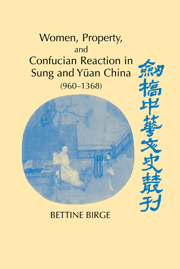Book contents
- Frontmatter
- Contents
- List of Maps, Figures, and Tables
- Chronology of Chinese Dynasties
- Abbreviations
- Acknowledgments
- Introduction
- 1 Women and Property before the Sung: Evolution and Continuity
- 2 Women and Property in the Sung: Legal Innovation in Changing Times
- 3 Women's Property and Confucian Reaction in the Sung
- 4 Transformation of Marriage and Property Law in the Yüan
- Conclusion: Gender, Mongols, and Confucian Ideals
- Bibliography
- Glossary-Index
Introduction
Published online by Cambridge University Press: 24 August 2009
- Frontmatter
- Contents
- List of Maps, Figures, and Tables
- Chronology of Chinese Dynasties
- Abbreviations
- Acknowledgments
- Introduction
- 1 Women and Property before the Sung: Evolution and Continuity
- 2 Women and Property in the Sung: Legal Innovation in Changing Times
- 3 Women's Property and Confucian Reaction in the Sung
- 4 Transformation of Marriage and Property Law in the Yüan
- Conclusion: Gender, Mongols, and Confucian Ideals
- Bibliography
- Glossary-Index
Summary
This book describes a transformation of gender and property relations that occurred in China between the tenth and fourteenth centuries, a period of rapid social and economic change and expanding foreign occupation. During much of this time, women's property rights were steadily improving, and laws and practices affecting marriage and property were moving away from Confucian ideals of patrilineality. Then the Mongol invasion of the thirteenth century and the subsequent confrontation between nomadic and sedentary culture precipitated a re-Confucianization of the law and a swing back toward patrilineal principles that deprived women of their property rights and reduced their legal and economic autonomy.
By using gender and property as its focus, this book provides a reevaluation of the Mongol invasion and its influence on Chinese law and society. It also presents a new look at the changing position of women in premodern China and explores the changing meaning of gender with all its contradictions as it was continually reinvented and reinforced. The transmission and control of property was an area of tension between government laws, Confucian ideology, social practice, and ethnic norms. It was a site at which gender constructions, moral standards, and ethnic identity were both defined and challenged, such that new sets of meanings emerged over time. Such themes are the subject of this book.
- Type
- Chapter
- Information
- Publisher: Cambridge University PressPrint publication year: 2002

